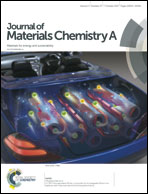Influence of crystal phase on TiO2 nanowire anodes in sodium ion batteries†
Abstract
Nanostructured TiO2 is a promising anode material for Na-ion batteries. In this work, we present a comparative study of anatase and B-phase TiO2 nanowires used for this purpose. We employ X-ray absorption spectroscopy and density functional theory in addition to standard characterization methods to reveal that Na is inserted into both anatase and B-phase nanowires, and that the reversible (de)sodiation capacity is almost the same for both. However the long-term stability of anatase-based Na-ion batteries is poorer than B-phase-based Na-ion batteries. We propose this is due to the irreversible formation of NaxTiO2 near the surface, which blocks Na diffusion. Improved Na-ion battery performance may therefore be obtained using TiO2(B) anodes and by choosing nanostructure geometries with rough surfaces, limiting the unwanted blocking ability of surface barrier layers.



 Please wait while we load your content...
Please wait while we load your content...